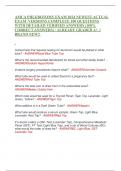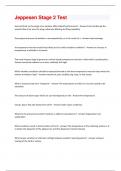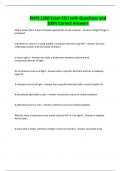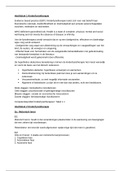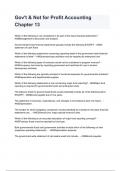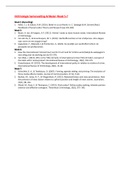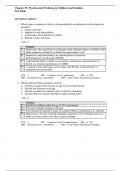BELEIDSINFORMATIESYSTEMEN
Bart Baesens
H1: Information systems, strategy and governance
Internet of things (IoT) = transmission of data by using internet attached sensors
Vb.: telematics = long-distance transmission of computerized information.
1.1. What is an IS?
Data Raw observed facts of events, without context not interpretable
Information Processed data useful for decision making process (who,what,where…)
Knowledge Ability to perform certain tasks by combining data with own information and experience
(which actions belong with what information)
Metadata Data about data
1.1.1. Types of systems
“A system is a set of elements. These elements are related to each other and, possibly, to
elements from the external environment and are joined for a specific purpose.”
Operational level Tactical level Strategic level
Short term Mid term Long term
Structured Less structured Almost unstructured
Workers Middle management C-level executives
OLTP (ex. Paypal), ERP, TPS MIS,DSS ESS, OLAP, DSS
1.2. IS strategy
1.2.1. Porter’s Five Force Theory (business
model)
Research: profitability in different industries
in America
Conclusion: variability cannot be attributed
only to internal competition/ rivalry =>
additional factors needed to explain
variability
Profitability decreases when low entry barrier, high bargaining power, high power of buyers, high
threat of substitute products or services, high rivalry among existing competitors.
Advantages Disadvantages
Generic, applicable to any company in any Of limited use for determining future strategy
industry
Provides detailed explanations for firm/ Few concrete guidelines in how to
industry profitability (descriptive) operationalize
Reason about an organization’s strategic
position with respect to its external
environment
,1.2.2. Value Chain Model
Value system: sequence of activities through which
inputs are transformed into more valuable outputs.
1.2.3. Henderson & Venkatraman
= strategic alignment model with IT as business
transformation enabler
IT can NOT lead to sustainable competitive advantage
External (strategy level) Business strategy Strategic integration ICT strategy
STRATEGIC FIT
Maximizing economic
performance, alignment
strategy and
implementation
Internal (operational level) Operational Operational ICT infrastructure
Infrastructure & integration & processes
processes
Business FUNCTIONAL FIT ICT
Alignment Business
and I(C)T
1) Strategic execution (donker groen)
business strategy -> Operational Infrastructure & processes -> ICT infrastructure & processes
Ex. Airline companies
2) Technology transformation (oranje)
business strategy -> ICT strategy -> ICT infrastructure & processes
Ex. Walmart
3) Competitive potential (geel)
ICT strategy -> business strategy -> Operational Infrastructure & processes
Ex. Google, Facebook, Amazon
4) Service level (zwart)
ICT strategy -> ICT infrastructure & processes -> Operational Infrastructure & processes
Ex. Microsoft, IBM, SAP
, 1.3. IS Governance
1.3.1. Corporate Governance
Scandals leading to changes (corporate governance):
- Enron scandal : huge energy company where people were scammed with fake holdings
to hide the huge amount of debts -> led to a bankruptcy in 2001. (same with Parmalat)
- Parmalat: fake 4 billion euro bank account -> brushed up image of solvency
- Société Générale: a rogue trader who had too much power to make important business
deals. This led to high risks and an enormous amount of debts to cover.
- Credit crisis in 2008
Still problem of Principal-agent:
- Shareholders want high ROI (high dividends/ stock price)
- Management sometimes focused on themselves (their career…)
1) SOX-law (by Sarbanes and Oxley): maintain basic principles of corporate governance
(protecting shareholders of firm and the public)
No compliance -> punishment for both company and managers
Ex.: 404: all information can be tracked to origin
I) COSO internal control (NOT IT focused)
= committee of sponsoring organizations
Most used IT framework to ensure internal control
5 components:
- Control environment
- Risk assessment
- Control activities
- Information & communication
- Monitoring activities
3 purposes:
- Operations
- Rapport
- Compliance
II) COBIT (developed by ISACA in 1996, last update 2019)(IT focused)
= control objectives for information and related technology
= Integrated business framework with a set of tools that ensures IT is working effectively
and generates value. Provides common language to communicate goals, objectives and
expected result to all stakeholders.
Process maturity analyses by means of process capability model
Process capability level: good = 4
4 benefits:
- IT integrations
- Improved risk management
- Discovery of gaps in security
- Creating a framework that provides more visibility to the board of directors
R(esponsibility)A(ccountables)S(upport)C(onsult)I(nform) chart/ matrix
= used to assign responsibilities
Bart Baesens
H1: Information systems, strategy and governance
Internet of things (IoT) = transmission of data by using internet attached sensors
Vb.: telematics = long-distance transmission of computerized information.
1.1. What is an IS?
Data Raw observed facts of events, without context not interpretable
Information Processed data useful for decision making process (who,what,where…)
Knowledge Ability to perform certain tasks by combining data with own information and experience
(which actions belong with what information)
Metadata Data about data
1.1.1. Types of systems
“A system is a set of elements. These elements are related to each other and, possibly, to
elements from the external environment and are joined for a specific purpose.”
Operational level Tactical level Strategic level
Short term Mid term Long term
Structured Less structured Almost unstructured
Workers Middle management C-level executives
OLTP (ex. Paypal), ERP, TPS MIS,DSS ESS, OLAP, DSS
1.2. IS strategy
1.2.1. Porter’s Five Force Theory (business
model)
Research: profitability in different industries
in America
Conclusion: variability cannot be attributed
only to internal competition/ rivalry =>
additional factors needed to explain
variability
Profitability decreases when low entry barrier, high bargaining power, high power of buyers, high
threat of substitute products or services, high rivalry among existing competitors.
Advantages Disadvantages
Generic, applicable to any company in any Of limited use for determining future strategy
industry
Provides detailed explanations for firm/ Few concrete guidelines in how to
industry profitability (descriptive) operationalize
Reason about an organization’s strategic
position with respect to its external
environment
,1.2.2. Value Chain Model
Value system: sequence of activities through which
inputs are transformed into more valuable outputs.
1.2.3. Henderson & Venkatraman
= strategic alignment model with IT as business
transformation enabler
IT can NOT lead to sustainable competitive advantage
External (strategy level) Business strategy Strategic integration ICT strategy
STRATEGIC FIT
Maximizing economic
performance, alignment
strategy and
implementation
Internal (operational level) Operational Operational ICT infrastructure
Infrastructure & integration & processes
processes
Business FUNCTIONAL FIT ICT
Alignment Business
and I(C)T
1) Strategic execution (donker groen)
business strategy -> Operational Infrastructure & processes -> ICT infrastructure & processes
Ex. Airline companies
2) Technology transformation (oranje)
business strategy -> ICT strategy -> ICT infrastructure & processes
Ex. Walmart
3) Competitive potential (geel)
ICT strategy -> business strategy -> Operational Infrastructure & processes
Ex. Google, Facebook, Amazon
4) Service level (zwart)
ICT strategy -> ICT infrastructure & processes -> Operational Infrastructure & processes
Ex. Microsoft, IBM, SAP
, 1.3. IS Governance
1.3.1. Corporate Governance
Scandals leading to changes (corporate governance):
- Enron scandal : huge energy company where people were scammed with fake holdings
to hide the huge amount of debts -> led to a bankruptcy in 2001. (same with Parmalat)
- Parmalat: fake 4 billion euro bank account -> brushed up image of solvency
- Société Générale: a rogue trader who had too much power to make important business
deals. This led to high risks and an enormous amount of debts to cover.
- Credit crisis in 2008
Still problem of Principal-agent:
- Shareholders want high ROI (high dividends/ stock price)
- Management sometimes focused on themselves (their career…)
1) SOX-law (by Sarbanes and Oxley): maintain basic principles of corporate governance
(protecting shareholders of firm and the public)
No compliance -> punishment for both company and managers
Ex.: 404: all information can be tracked to origin
I) COSO internal control (NOT IT focused)
= committee of sponsoring organizations
Most used IT framework to ensure internal control
5 components:
- Control environment
- Risk assessment
- Control activities
- Information & communication
- Monitoring activities
3 purposes:
- Operations
- Rapport
- Compliance
II) COBIT (developed by ISACA in 1996, last update 2019)(IT focused)
= control objectives for information and related technology
= Integrated business framework with a set of tools that ensures IT is working effectively
and generates value. Provides common language to communicate goals, objectives and
expected result to all stakeholders.
Process maturity analyses by means of process capability model
Process capability level: good = 4
4 benefits:
- IT integrations
- Improved risk management
- Discovery of gaps in security
- Creating a framework that provides more visibility to the board of directors
R(esponsibility)A(ccountables)S(upport)C(onsult)I(nform) chart/ matrix
= used to assign responsibilities



